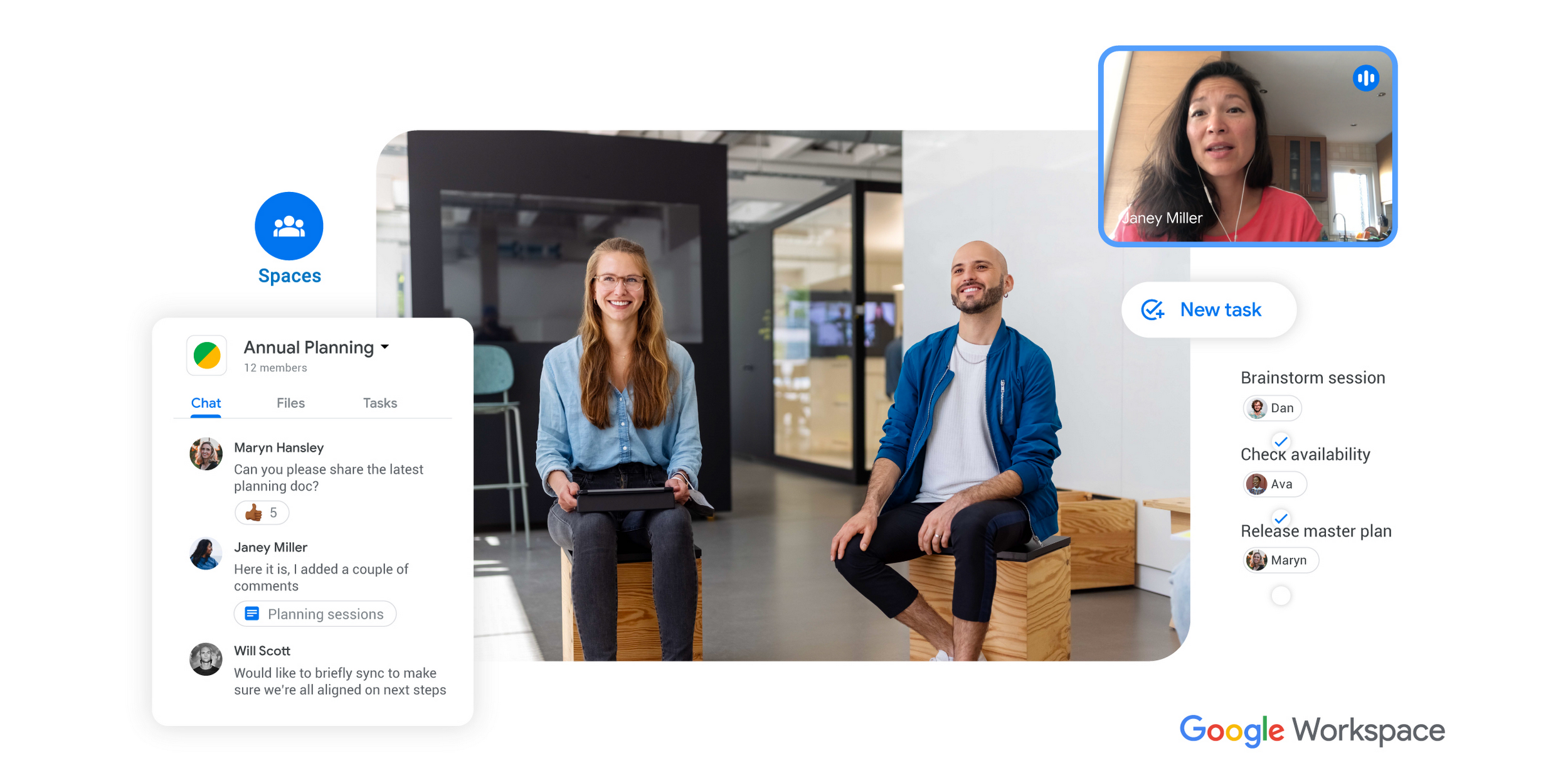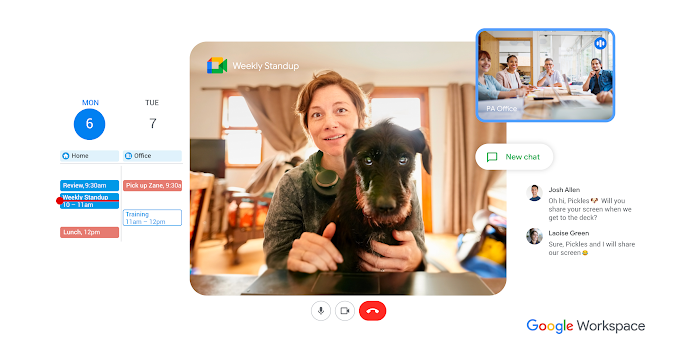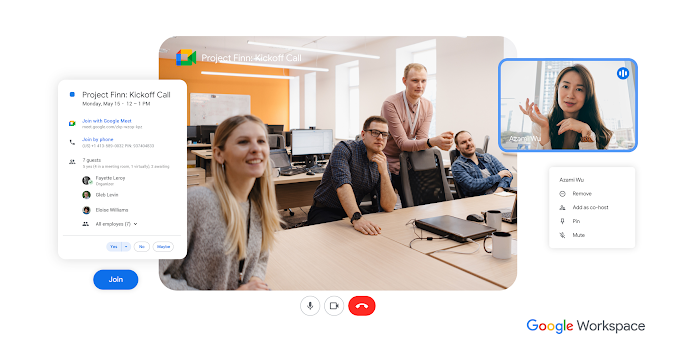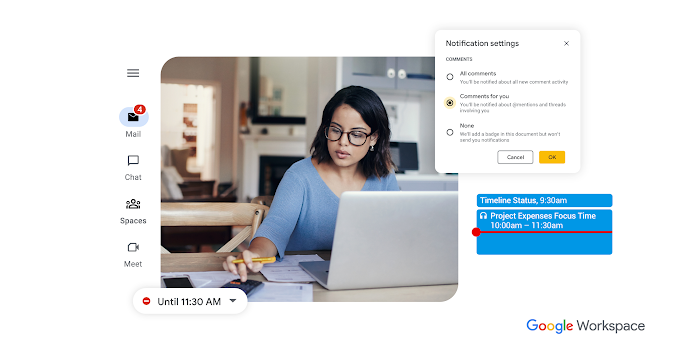Hybrid vs. remote work

The Google Workspace Team
Google Workspace Newsletter
Keep up with the evolving future of work and collaboration with insights, trends, and product news.
SIGN UPThe difference between remote and hybrid work
In recent years, remote work and hybrid work have gained in popularity due to the benefits that working outside of a traditional office environment offers both companies and their employees.
Remote and hybrid work rely heavily on technology to keep employees and teams connected. The right work solutions equip teams with the tools and applications they need to work seamlessly, stay on top of project milestones, and maintain team engagement. Although hybrid work and remote work have similarities, there are several key differences between the two.
What is remote work?
Remote work allows employees to work from any place of their choosing outside of a standard office environment provided by their employer. Although many remote employees choose to work from home, some opt to work in a more social environment, like a coworking space.
Essential components of remote work
Google Workspace offers a suite of thoughtfully-connected apps to help remote teams get more done — together.
Virtual communication: Regular check-ins with project leads, team members, and coworkers give greater visibility into timelines and progress updates. Regular communication via video conference calls with Google Meet, or instant messages via Google Chat, help teams of all sizes stay connected and move work forward. Teams of all sizes can even keep the files and conversations related to a project organized by topic with spaces in Chat.
Online team collaboration: Remote work opens the door to even greater opportunities to collaborate with team members in all corners of the world. Whether you’re collaborating on polished presentations in Google Slides, pulling together data or project trackers in Google Sheets, or brainstorming in Google Docs, up to 100 people can work on the same file at the same time.
Stay in sync: Successful remote work teams have defined processes in place to help get things done and stay in sync. Understanding who is responsible for a specific portion of a project, review process, or deadline allows remote teams to tackle work effectively. Google Workspace apps like Google Calendar allow you to schedule meetings, block off focus time for work, and more.
Reliable and easy-to-use technology: With Google Workspace, there are no downloads or plug-ins required. Work from any device (laptop, tablet, computer, mobile phone, etc.) with a browser and a Wi-Fi connection. You can even work in offline mode when you can’t access the Internet.
Security protocols: Organizations with remote workers need to have advanced encryption to protect stored and shared data. Google Workspace protects your data in emails, chats, video meetings, and files stored in the cloud to prevent breaches of sensitive information.
Benefits of working remotely
Remote work offers both employees and employers a variety of benefits, including:
Reduced expenses: With teams working remotely, it translates to less overhead to lease and manage a physical office space. Similarly, team members who no longer commute save on transportation costs.
Access to top-tier talent: In a remote-work scenario, employers aren’t limited to a specific geographic region. They can hire the best candidates for a given position from anywhere in the world.
Work-life balance: With commute time reduced, team members have more time to recharge after working hours. This can help them be more energized and productive when it’s time to work, as well as give them more space to come up with fresh ideas.
Flexibility: Remote work offers greater flexibility for employees to do their best work. Typically, remote work comes with set expectations around working hours. Depending on an organization’s remote work policies, remote workers may have some degree of flexibility around set working hours. This allows team members to have regularly scheduled sync-ups during core business hours, while preserving flexibility during other times of the day.
Increased productivity: Remote work can translate to greater productivity thanks to fewer distractions employees might have compared to a traditional office setting. Remote employees have more freedom to work in an environment of their choosing — whether that’s a quiet room in their home or a bustling coffee shop.
What is hybrid work?
Hybrid work involves employees splitting their work week between a traditional, in-office setting and working from home or another environment of their choosing. Some hybrid work schedules are flexible, with employees deciding which days they work from home or the office, and some schedules are set by managers, who determine which days employees work on-site or remotely.
Essential components of hybrid work
To make hybrid work work for your team, there are a few key components to keep in mind:
Digital collaboration: Communication and collaboration is at the heart of any business or enterprise. In a hybrid-work scenario, some team members may be working from home on a given day, while others are in the office. Since many hybrid teams are in the office for different reasons, a suite of connected solutions is essential to make asynchronous collaboration possible. Google Workspace makes it easy for teams of all sizes to stay connected and productive across email, chat, files, and meetings.
Physical workplace: Hybrid employees require an office to work from part of the week. Making sure you have a physical space where teams can convene, equipped with supplies and technology to help them work effectively goes a long way to making hybrid work – work. Cloud-based hybrid work solutions like Workspace make it easy for teams to connect, collaborate, and work independently on shared files on days at the office or when working from home. Features like companion mode in Google Meet ensure that everyone can fully participate in the conversation, no matter where they’re joining from.
Team connection: In a hybrid-work environment, meaningful connections matter. Get status updates on projects or post conversational icebreakers in Chat to build team camaraderie. Hold regularly scheduled video meetings or have a virtual coffee with colleagues in Meet. Google Workspace brings your team closer together.
Secure solutions: Hybrid work environments need secure solutions to prevent data breaches and ensure safe access and storage of digital information. Google Workspace is built on a secure foundation with zero-trust to protect your data. Administrators have access to a wide range of controls and can adjust access permissions for the entire organization, individuals, or specific teams.
Benefits of hybrid work
There are numerous benefits to hybrid work for both teams and employers, including:
Flexibility: Some days, you just want an uninterrupted block of time to focus on your most important projects. On other days, a bustling office can provide the jolt of inspiration and collaboration needed to power through. A hybrid work schedule offers options to work alongside teams in the office, or to work from home to create a stronger sense of work-life balance.
In-person interaction for stronger human connections: A hybrid work environment can provide teams with more opportunities to connect in person, building stronger bonds that lead to increased trust and team performance.
Employee oversight: Hybrid work gives managers and teams a more predictable pulse on employees’ schedules. This can help them connect with teams and direct reports to help them manage their workload, support, or answer questions.
How does Workspace help facilitate remote and hybrid work?
Google Workspace combines thoughtfully connected applications to help teams of all sizes connect, create, and collaborate in any work environment. A secure, cloud-based infrastructure ensures safety and reliability when sharing files, emails, or during video calls and meetings.
1. Conduct virtual meetings
In a hybrid or remote work environment, communication is an essential ingredient to success. Google Meet allows you to host virtual meetings for up to 1,000 people or broadcast a live stream to tens of thousands of people. Whether you’re scheduling a weekly team meeting or status update or holding a webinar to build new relationships for your organization, Meet makes it happen.
2. Collaborate seamlessly
An intuitive, easy-to-use interface makes it simple to create and collaborate in real-time with your team on Docs, Sheets, and Slides. Up to 100 people can collaborate in a single file at one time and you can share files with up to 600 people.
3. Stay connected
Connected apps create connected teams. Google Workspace combines a full suite of apps to help keep hybrid and remote teams on the same page. Have real-time conversations in chat. Keep a pulse on team schedules and schedule meetings or events in Google Calendar. Securely house files in Drive, offering cloud-based access to shared Docs, Slides, and Sheets.
Hybrid vs Remote FAQs
Do people prefer hybrid or remote work?
Everyone is different! Some people prefer hybrid work because it allows them more face-to-face connection with team members and greater separation between work and home. Other people thrive in a remote work environment, preferring a quiet corner of their home without braving a lengthy commute. Ultimately, it’s all about the place that allows you to do your best work and the right tools to support it.
What is an example of a hybrid job and what is an example of a remote job?
A hybrid job may have a split schedule. This means that an employee works on-site for, say, three days out of the week and works from home – or in a location outside the physical office – on the remaining two days of the work week. With a remote job, an employee works from home or a flexible location of their choosing full-time.
Can a hybrid job be fully remote?
A hybrid job may be partially remote, but not often fully remote. In some instances, a hybrid employee may work remotely nearly all of the time, but may commute to the office for certain occasions, such as meeting a client on site, for team activities, or company-wide meetings and functions.
How many days in the office is considered hybrid working?
How often an employee works in-office with a hybrid work schedule depends upon the employee and the organization. Typically, many hybrid work schedules involve an employee working in-office either 2-3 days per week. Even more flexible hybrid work scenarios allow employees to commute to their company’s office 1-2 days per week. Some companies foster alternating hybrid work schedules where an employee works one full week from the office and works from home the following week, while others favor a remote-first hybrid model where employees can work remotely most of the time, but work from the office when it’s more convenient.
Get started with Google Workspace
Google Workspace offers flexible hybrid and remote work solutions for businesses of all sizes. Choose the plan that’s right for you.
Try Google Workspace for hybrid work
For small business
For enterprise



